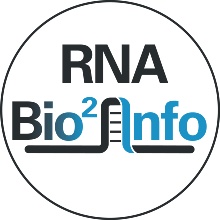Further Info
A striking new role for RNAs is their widespread involvement in the regulation of numerous genes, suggesting that there is much yet to discover about these amazing cellular components.
Philip A. Sharp, 2009, The Centrality of RNA, Cell
RNA has central functions in all living organisms. We are interested in its regulatory functions and resulting regulatory networks, which we study in wet & dry lab. Our mission is to develop and improve high-throughput methods, to design specialised bioinformatics tools for their analysis and to finally turn all this into knowledge about RNA-based regulation.
The Computational Biology group works interdisciplinary and combines expertises in RNA biochemistry, the analysis of NGS data and the development of algorithms for the analysis of RNA structure. Furthermore, we are interested in the interactive visualization of networks, we run the institutes Galaxy Server and offer bioinformatics consultation.
Most of our projects are based on our general interest in the cellular functions of RNA.
Our Topics of Interest
RNA is not only a passive messenger of information as mRNA, but also possesses regulatory and catalytic functions. A self-contained, non-coding RNA (ncRNA) can regulate other RNAs (mRNAs & other ncRNAs) via complementary base pairing, which hampers translation or triggers degradation of the target. Commonly, ncRNAs have several targets and mRNAs are targeted by several ncRNAs, such that complex regulatory networks exist. These networks are our subjects of interest and we study them experimentally and computationally. The overall aim is to comprehensively describe these networks, to analyse their dynamics (evolutionary, conditionally, temporally) and to predict advantegeous changes or even completely synthetic regulatory circuits.
Direct Duplex Detection methods provide detailed information about RNA:RNA interactions at nucleotide resolution. The analysis of the resulting sequencing data goes beyond standard RNA-seq analysis and needs specialized tools and statistics for significance analysis.
Metagenomic data provides a wealth of biological diversity and thus is a promising source for the identification of new CRISPR-Cas systems and for their initial characterisation. The complex nature of metagenomic data poses several challenges for an efficient and comprehensive analysis. We use graph-based approaches for this task and develop algorithms for CRISPR-Cas detection, spacer/repeat identification and protospacer searching.
RNA functions at the structural level, similar to proteins, thus structure analysis helps to understand the function of an RNA molecule. Noteworthy, the major loss of free energy takes place by the formation of hydrogen bonds between complementary base pairs and, especially, the stacking of these base pairs. As a consequence the secondary structure dominates the shape of an RNA and is thus the subject of interest in structural studies. We work on methods for the analysis of the structure space of RNAs, which delivers information about alternative structures, e.g. as in Riboswitches, folding kinetics and evolutionary conserved structures. For example, we have developed the tool RNAHeliCes (see Software section) which is described in detail in Huang,J. and Voß,B. (2014) Analysing RNA-kinetics based on folding space abstraction. BMC Bioinformatics, 15, 60 and Huang,J., Backofen,R. and Voß,B. (2012) Abstract folding space analysis based on helices. RNA, 18, 2135–2147.
Software
Efficient Analysis of RNA interactome data from Direct Duplex Detection experiments like SPLASH, LIGR-seq, PARIS and others. We also have a preconfigured docker container that you can find here: RNAnue docker container
A tool for the interactive visualisation of Graphs within Galaxy.
Analysis of the folding space of RNA is mainly hampered by its size, because it grows exponentially with sequence length. Structure abstraction is a method to dampen the exponential explosion and to focus on structures that are different in shape rather than single basepairs. RNAHeliCes focusses on helical regions within structures that are represented by the type of structural element they enclose and the position at which they occur in the sequence.
Differential RNA-seq is a widely used method for the prediction of Transcriptional Start Sites (TSSs) in bacteria. With RNAseg we make use of this information, but additionally use the overall coverage of reads over the genome to predict Transcriptional Units (TUs) genome-wide.
Recent Publications of the Group
- B. Voß, “Classified Dynamic Programming in RNA Structure Analysis,” Methods in Molecular Biology, pp. 125–141, Feb. 2024, doi: 10.1007/978-1-0716-3519-3_6.
- R. A. Schäfer et al., “RNA Interaction Format---a General Data Format for RNA Interactions,” p. btad665, 2023, doi: 10.1093/bioinformatics/btad665.
- R. A. Schäfer and B. Voß, “RNAnue: efficient data analysis for RNA–RNA interactomics,” Nucleic Acids Research, Art. no. gkab340, May 2021, doi: 10.1093/nar/gkab340.
- R. A. Schäfer, S. C. Lott, J. Georg, B. A. Grüning, W. R. Hess, and B. Voß, “GLASSGo in Galaxy: High-Throughput, Reproducible and Easy-to-Integrate Prediction of sRNA Homologs,” Bioinformatics, Art. no. btaa556, Jun. 2020, doi: 10.1093/bioinformatics/btaa556.
- O. S. Alkhnbashi, T. Meier, A. Mitrofanov, R. Backofen, and B. Voß, “CRISPR-Cas Bioinformatics,” Methods, vol. 172, pp. 3–11, Feb. 2020, doi: https://doi.org/10.1016/j.ymeth.2019.07.013.
- B. Schönberger, C. Schaal, R. Schäfer, and B. Voß, “RNA interactomics: recent advances and remaining challenges,” F1000Research, vol. 7, p. 1824, Nov. 2018, doi: 10.12688/f1000research.16146.1.
- S. C. Lott et al., “GLASSgo - Automated and reliable detection of sRNA homologs from a single input sequence,” Frontiers in Genetics, vol. 9, 2018, doi: 10.3389/fgene.2018.00124.
- D. Stazic and B. Voß, “The complexity of bacterial transcriptomes,” Journal of Biotechnology, vol. 232, pp. 69–78, Aug. 2016, doi: 10.1016/j.jbiotec.2015.09.041.
- R. A. Schäfer and B. Voß, “VisualGraphX: interactive graph visualization within Galaxy,” Bioinformatics, p. btw414, Jul. 2016, doi: 10.1093/bioinformatics/btw414.





